Abstract
Modern sport technology is a rapidly evolving scientific field utilizing leading techniques, such as the internet of things (IoT), augmented reality (AR), virtual reality (VR) and the use of many kinds of sensors. The feedback and the support provided by technology seem to have the potential to bring sufficient changes in sports training following a new trend, which is trying to integrate modern technology into sports. The aim of this study is to integrate responsive feedback and internet of things (IoT) technology into sports mainly in order to support the training of novice bowling athletes, raise their engagement with their sport and boost their performance. Following this direction, this research utilizes a system of sensors to apply step tracking of a bowling athlete during a throw ball attempt. The proposed solution is a European-funded project (ERASMUS+) supporting the “Europe 2020 strategy” to motivate people to transform their learning experiences into a beneficial way of constructing better performance. The results of the proposed system evaluation showed that bowlers and their coaches highlighted its usability and its usefulness. Thus, the proposed system may prove a valuable tool supporting athletes in general, and more particularly, novices’ training in bowling.
1. Introduction
In the past, traditional sport training required careful observation and, in many cases, handwritten notes to record any possible technical mistakes by athletes that could be detected. Technology has the potential to bring about significant changes to modern training activities by providing real-time feedback in great detail, detecting situations that are not easily perceived by the naked eye. This feedback can more effectively support self-regulation and performance improvement.
There are several modern and advanced forms of training, where the various internet of things (IoT) techniques are used to support both individual and group levels [1] in the following ways:
- Individually, IoT techniques can help improve skills and monitor performance for the period of time of interest.
- At the team level, IoT equipment, especially wearables, can collect critical data that support the improvement of strategy, collaboration and interaction within a team activity.
The aim of this research is to develop a technological solution that can combine IoT techniques with individual practice focused on improving skills.
It is widely accepted that bowling is a low-intensity sport activity combined with entertainment and socialization. It often happens that people are attracted to this sport, and in many cases, companions or friends play bowling for fun. It is therefore clear that, occasionally, people get excited when they start playing. However, after a while, they lose their initial enthusiasm, and they stop getting involved with this sport activity. One possible reason is that they do not have the opportunity to deepen and practice the bowling technique. Therefore, they do not feel any improvement in playing bowling, they are disappointed, and they drop out [2].
Based on the above and trying to better understand and analyze the bowlers’ needs and define the appropriate requirements to support novice bowlers in improving their skills and staying engaged with the sport, an online questionnaire was used. It was answered by both bowling athletes and coaches to identify their needs and specify the areas where some digital tools might be useful. Examining both the athletes’ and coaches’ answers, footwork techniques were found to be a very important aspect to be improved.
Thus, an IoT toolbox and a corresponding application were developed. This system detects the step tracking of a bowling athlete during a throw. Then, the retrieved data are stored in a database.
Furthermore, a dashboard was developed presenting data and analytics of every athlete attempt.
The present paper is structured as follows. Section 2 deals with the literature review. Section 3 presents the research questions of this project. Section 4 deals with the step tracking device, its connected mobile application and the monitoring web application. Section 5 refers to the assessment activity, the procedure and the evaluation methodology followed to examine the ease of use, usefulness, ease of learning and satisfaction provided by the proposed step tracking system. Then, Section 6 presents the evaluation results provided by the statistical analysis and a discussion on them. Section 7 refers to the limitations of this research. Finally, Section 8 summarizes the concluding remarks and outlines the future steps of the presented research work.
2. Related Work
The use of technology can facilitate the acquisition of sports skills and improve the performance of athletes [3]. Modern technology supports sports training by providing real-time feedback, since it offers the possibility of detailed detection of athletes’ movements or their fitness condition in general, which are not easily perceived by the naked eye.
Modern sports training methods are evolving rapidly, since they are trying to follow the fast-growing competition and demands placed on novice athletes. In the present day, most sports require athletes to perform both physically and mentally. A modern-day athlete needs to understand the information received from their training environment and interpret it in the context of their sport activity including past experiences in order to make high-quality decisions and improve his/her performance [4].
Advancements in virtual reality (VR) and augmented reality (AR) technology are revolutionizing the bowling experience and training. VR bowling simulations allow players to train themselves in realistic virtual environments. Moreover, AR applications provide instant and immersive feedback during live gameplay. These technologies enhance the fun and excitement of bowling while offering valuable training capabilities, especially for novices [5].
In addition, artificial intelligence (AI) technology contributes to bowling ball design, offering players at all levels a chance to significantly improve their performance. This technology provides an advanced design and construction of balls that can spin more efficiently and hit the pins harder, improving the throw results. This special part of AI is called AI CORE, and it deals with the improvement of construction of hardware components, taking advantage of AI tasks. Scientists specialized in the AI CORE field examine in depth how the bowling ball interacts with pins. Thus, the AI CORE technology is specifically engineered to optimize the factors that affect the chances of a strike even in non-ideal conditions. Comparative studies between balls equipped with this technology and common ones showed that balls utilizing AI CORE consistently outperformed others, particularly in challenging positions, where precision is critical. Thus, the AI CORE technology succeeds in providing better performance [6].
Another prominent form of modern technology is the internet of things (IoT), which can apply many advanced techniques, such as emotional awareness, motion capture and skeletal tracking, to various forms of sport activities.
One very interesting and innovative feature in bowling technology is the development of smart bowling balls. These are balls equipped with sensors. The sensors are connected to applications that provide real-time feedback on the ball speed, rotation and impact angle. These data allow bowlers to analyze their performance with detailed accuracy and identify the areas for skill and technique improvement [5].
Tung Mun Hon [7] utilized a wireless inertial sensor (a sensor measuring specific forces) attached to human wrist. This sensor was connected to an interactive graphical user interface analyzing the arm movement of the bowler. One critical limitation of this research is that this system dealt with a limited number of motion parameters, showing a restrictive assessment of the bowler’s technique.
Moreover, in another research, Razman [8] examined anthropometric measurements analyzing 43 (forty-three) kinematic variables extracted from the examination of the players’ 3D motion. This study stated that foot tracking is a very important factor affecting bowling performance. Two significant parameters of footwork tracking are a consistent foot lateral position and the more varied foot slide distance. In addition, Razman et al. [9] stated that consistency in front foot slide is highly connected to the accuracy of ball release.
In a study examining in detail the delivery technique of elite ten-pin bowlers on the bowling lane, Chu et al. [10] showed that the pace and stepping pattern of the footwork could lead to improved results with regard to timing, balance and a strong finish.
The aforementioned research works point to the fact that footwork is a very important factor in bowling, leading to a successful ball release. This statement is strongly supported by experienced bowlers paying particular attention to stepping accuracy. This accuracy is based on walking consistently and knowing precisely when the athlete will slide on, regardless of where he/she aligns him/herself on the approach [11].
Furthermore, many experienced bowlers and coaches agree that, in general, footwork is the foundation of good bowling. It is a significant factor affecting the timing, balance, rhythm, direction, ball speed and the ability to release the ball with power, accuracy and consistency. In more detail, it is stated that the length of the entire approach and step direction are important parameters of footwork, leading to better performance [12].
Thus, our research, based on the aforementioned critical parameter of step detection, focuses on footwork tracking to support effective bowling training, mainly for novices. We tried to take advantage of the use of modern technological features to present a useful and effective intervention system called STAYInBowling—step tracking.
Moreover, considering the ultrasonic sensors utilized by the proposed research, they are cost–effective sensors detecting objects without physical contact. They have experienced considerable growth, utilized in many innovative applications such as automotive systems, industrial automation and precision agriculture [13]. They are used in parking assistance systems installed in front and rear bumpers [13,14]. In addition, they are used in smart agriculture to detect crop growth and density in real–time [13].
3. Research Questions
The aim of the proposed project is the creation of a digital toolbox and the corresponding applications to support better coaching and training of bowling athletes. As a result, a mobile application with real-time and responsive feedback, utilizing the appropriate sensors, was created, aspiring to enrich bowling training with an engaging, supportive and useful experience.
Moreover, a web dashboard application connected to a database was developed, presenting the measurements gathered from the step tracking system as sport analytics. This application aims to help coaches better understand the status of their athletes and to support the athletes themselves in self-assessment and self-regulation. In addition, this application supports the decision making for functional adaptations required over time.
This article is exploring the following research questions, examining the athletes’ and coaches’ perceptions of four (4) evaluation factors after utilizing the proposed system:
- Q1: Usefulness. Is the system useful as a bowling training equipment?
- Q2: Ease of use. Were there difficulties while applying the system in training?
- Q3: Ease of learning. Did users easily understand the system operations?
- Q4: Satisfaction. Did users enjoy their training utilizing the system?
4. System Analysis, Design and Development
This section presents the system analysis, the design methodology followed and the development of the proposed system.
4.1. System Analysis
The project followed an initial phase of analysis of the needs and the requirements that the proposed solution will satisfy. In this phase, the need for deepening and better practicing the bowling technique was clarified, and the objectives of the proposed system under construction were defined.
To better understand the scope for improvement in bowling training, a questionnaire was created and handed to bowling athletes and coaches during several dissemination events. The participants included 72 people; 23.61% were female, and 76.39% were male. Most of them were aged 51–65 years. Moreover, 64% of respondents identified themselves as amateur athletes. As an instrument for gathering bowling training needs, a questionnaire was developed and organized into the following five sections:
- Demographic information (Section 1).
- Assessment of information technology proficiency (Section 2).
- Bowling expertise (Section 3).
- The experience of bowlers (Section 4).
- The experience of bowling coaches (Section 5).
Depending on the condition (whether they were athletes or coaches), respondents accessed sections 4 (four) or 5 (five) exclusively. Respondents were asked to declare their preferred learning methods and the way they have learned to play bowling personally.
Most athletes (51%) learned to play bowling individually trained by a coach. Moreover, a sufficient number (43%) of athletes learned to play with friends and fellow athletes. Furthermore, as a supportive material, video platforms seemed to be the most popular (22%). Regarding their level and experience, most of them were interested in improving footwork, ball release and hooking techniques. Moreover, most coaches pointed out footwork and timing techniques as two very important factors in novice bowlers’ training.
Following the aforementioned responses, the requirements for the proposed system were ascertained, and a use-case diagram of the proposed project was established (Figure 1). The athlete is measured by the IoT toolbox consisting of the essential sensors. These measurements are displayed in real-time by a mobile application and during a time period by a web dashboard. The system is described in more detail in the following sections.
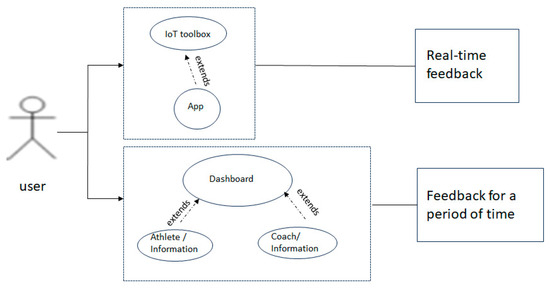
Figure 1.
Use-case diagram.
4.2. System Design and Architecture
The proposed system (STAYInBowling—step tracking) consists of four sub-systems (Figure 2):
- The IoT toolbox.
- The mobile application.
- The database schema.
- The dashboard web application.
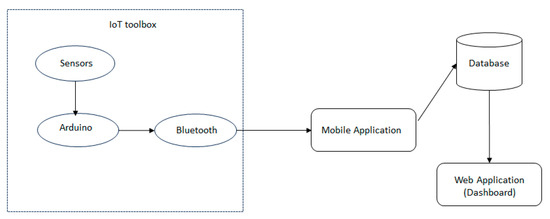
Figure 2.
System architecture.
4.3. System Implementation
The proposed system was implemented following the aforementioned sections of system analysis and design.
4.3.1. IoT Toolbox
This sub-system is the step tracking equipment consisting of two ultrasonic sensors (URM37 V3.2) (Figure 3). An ultrasonic sensor is an instrument that measures the distance to an object using ultrasonic sound waves. It uses a transducer to send a pulse and to receive the echo. The sensor determines the distance to an object by calculating the half time of the emission and reception of ultrasonic pulse. Ultrasonic sensors operate like a radar system, since they send waves and measure the time it takes for them to return after hitting an object [15]. This kind of sensor provides a detection range of 4 cm–5 m and a resolution of 1 cm [16].
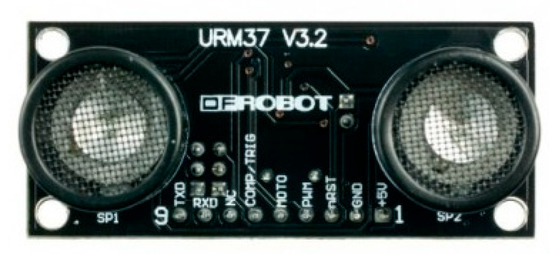
Figure 3.
The ultrasonic sensor URM37 V3.2.
Each sensor is placed on a tripod, whose height is foldable, to be adaptive to every athlete’s height. The two tripods are placed next to each other in a fixed predefined distance according to the width of the lane where the athlete is moving (Figure 4). At the beginning of the bowling alley, there is the first set of in-line dots. One tripod is placed on the same line as the second dot from the left end, and the other tripod is placed on the same line as the second dot from the right end.
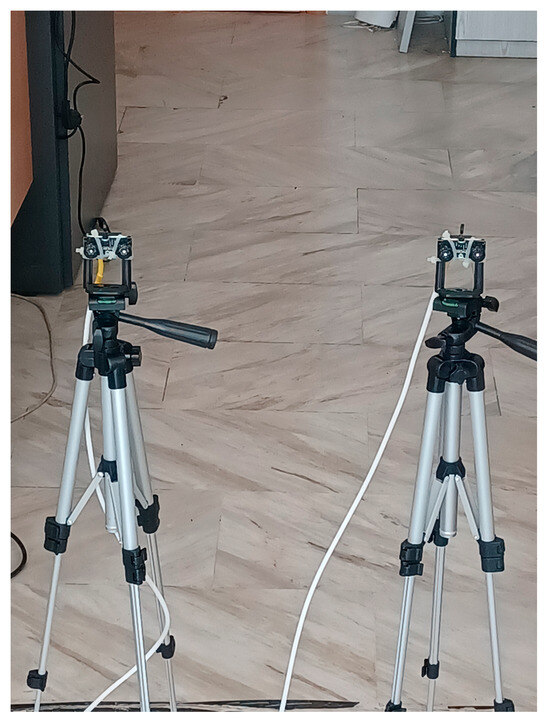
Figure 4.
The two sensors on the tripods at a fixed distance next to each other.
In addition, the sensors are connected to a box (Figure 5) containing an Arduino UNO microprocessor and a Bluetooth module (HC-05) (Figure 6).
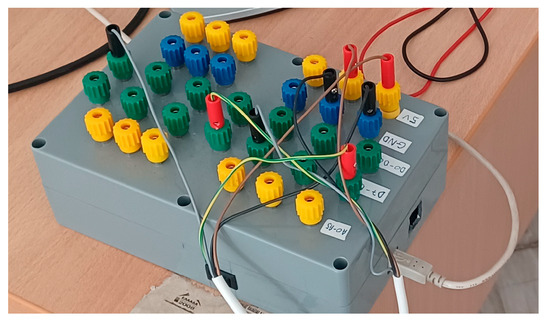
Figure 5.
The box connected to the sensors.
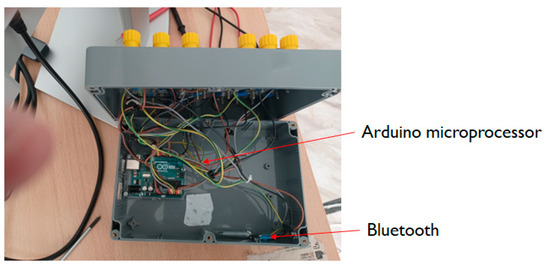
Figure 6.
Arduino microprocessor and Bluetooth module inside the box.
The aforementioned equipment costs approximately EUR 100, which is quite low, and it could be affordable for most bowling clubs and academies.
During the bowling training, the system of the two ultrasonic sensors is placed behind the bowling lane, and the sensors look forward and are set to the hip height of the athlete. When the athlete begins his/her approach, for every step, the Arduino microprocessor calculates the step number, duration, direction and projections of every step distance from the left and right sensors. In addition, for all steps, the total number of steps and total duration are measured. More specifically, the direction of every step is calculated from the two ultrasonic sensors placed at a distance between them and forming a virtual triangle with the athlete’s step [17]. Thus, considering every step as arc (C), one sensor as arc (A) and the other sensor as arc (B), if the distance from sensor B is greater than that from sensor A (i.e., BC > AC), then the bowler steps to the left and vice versa (Figure 7).
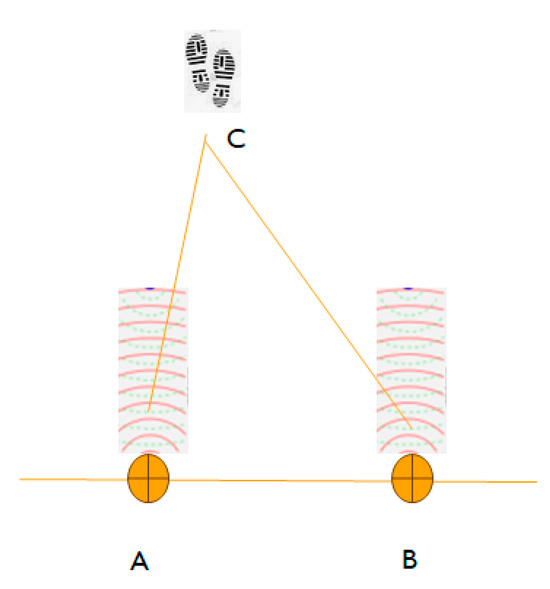
Figure 7.
Step direction detection.
Considering the aforementioned virtual triangle, the distance from the triangle side AB to arc C is the triangle height CE (Figure 8), which is the actual distance of every step, and it is calculated utilizing the Heron formula to find the area of a triangle in terms of the lengths of its sides.
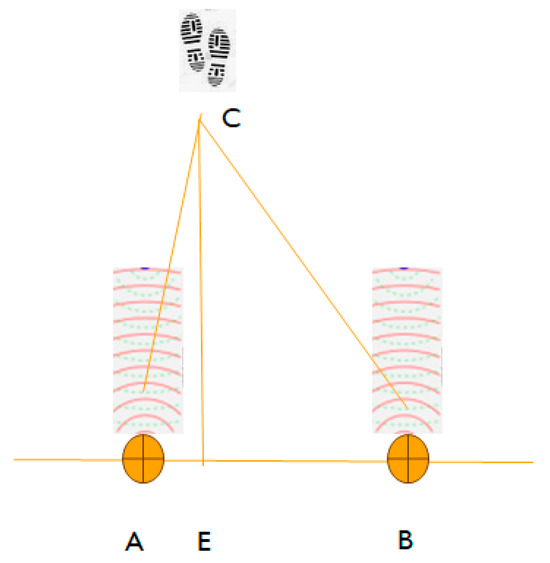
Figure 8.
The distance from athlete’s step.
According to this theorem, if AB, BC and CA are the lengths of the sides, the area (AR) is calculated as follows:
where S = (AB + BC + CA)/2.
AR = √ S × (S − AB) × (S − BC) × (S − CA),
Moreover, in every triangle where the height is H and the corresponding side is V, the area is calculated using the formula AR = 1/2 × H ×V too. Thus, utilizing the Heron formula, the area (AR) is calculated, and then, the height H can be found as follows:
H = (2 × AR)/V.
In our case (Figure 8), applying the aforementioned formulae, the sides of the virtual triangle are known, since the AB is fixed, and the AC and BC are calculated by the sensors. Thus, the area of the virtual triangle is calculated as AR = √ S × (S − AC) × (S − BC) × (S − AB). Then, utilizing the known value of the triangle area AR and the fixed AB triangle side, the height CE, which is the actual distance from the athlete’s step, is calculated using the formula CE = (2 × AR)/AB.
Then, in order to calculate the left projection margin (AE) and the right projection margin (BE) of every step, the Euclidean theorem is applied. Thus
AE = √ ((AC)2 − (CE)2) and BE = √ ((BC)2 − (CE)2)
4.3.2. The Mobile Application
The mobile application is connected to the IoT toolbox, gathering the sensors’ measurements in the form of a string:
“StepNO—step duration in seconds—step direction—left margin in cm—right margin in cm” for every step.
In the previous string, at the end of the athlete’s approach, the string “total step number—total duration in seconds” is added for the final total, ending the complete string of measurements.
These data are further processed to display feedback through a real-time responsive interface. Thus, the application shows the metrics of every bowler approach.
When the user launches the mobile application, the initial screen (Figure 9) has two options: “START” and “QUIT”.
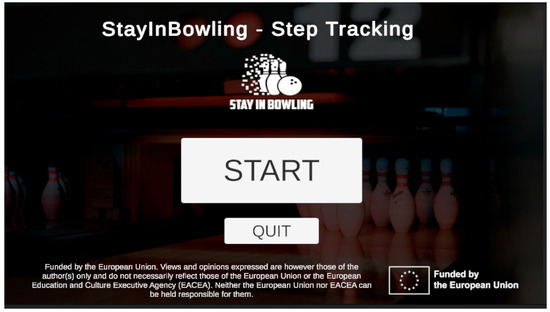
Figure 9.
The initial screen of the mobile application.
Pressing the “START” button launches another screen (Figure 10), retrieving all athletes’ user codes from the database. The coach can choose his/her specific athlete’s user code under which the step tracking metrics will be stored in the database.
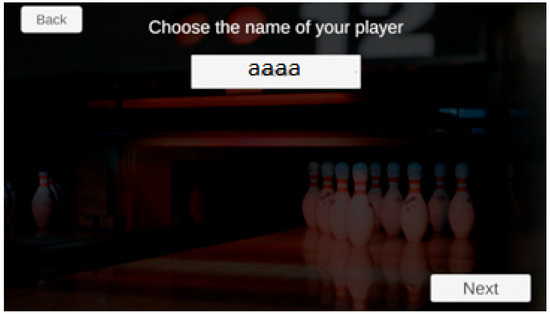
Figure 10.
The screen for choosing the athlete’s code.
After pressing the “NEXT” button, a new screen is displayed, which shows the step tracking feedback. The user has to press the “CONNECT” button to connect to the Bluetooth of the IoT toolbox (Figure 11). Then, the user has to press the “START” button when the athlete begins his/her approach, and when the athlete completes his/her attempt, the “STOP” button must be pressed to display the feedback of the athlete’s metrics (Figure 12). More specifically, the presented feedback will be separated into three categories:
- Total step duration.
- Total steps.
- Step details “stepNO—step-duration in seconds—direction—left margin in cm—right margin in cm”.
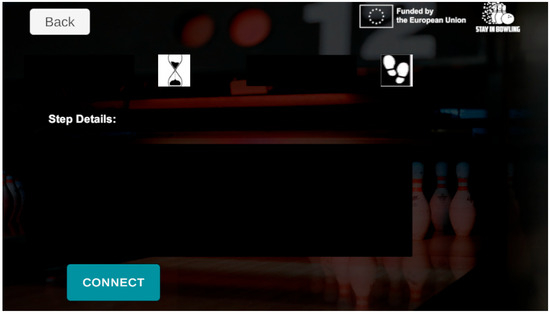
Figure 11.
The screen for pressing the CONNECT button.
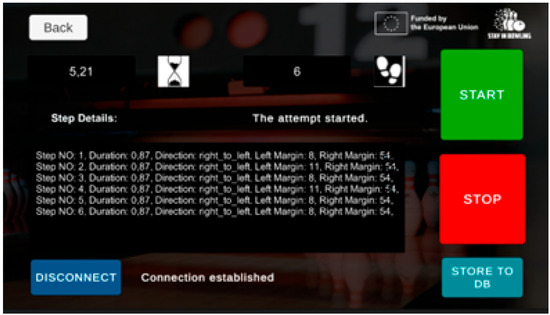
Figure 12.
The mobile application feedback.
When the user presses the “STORE TO DB” button, the data are routed to a server, and they are stored in the database under the aforementioned selected user code.
4.3.3. The Web Application (Dashboard)
This is a web application utilizing Nodejs and Reactjs technology (Figure 13). The first time that a user logs in this application, he/she selects his/her role as athlete or coach, or even both (Figure 14).
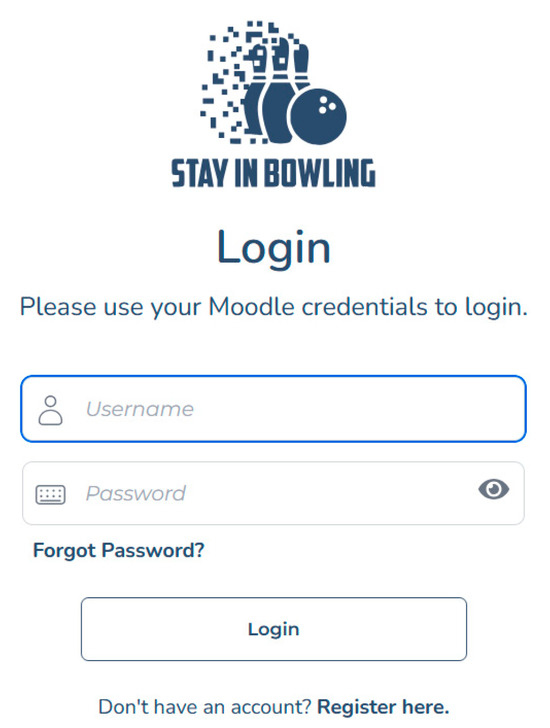
Figure 13.
The web application (login).
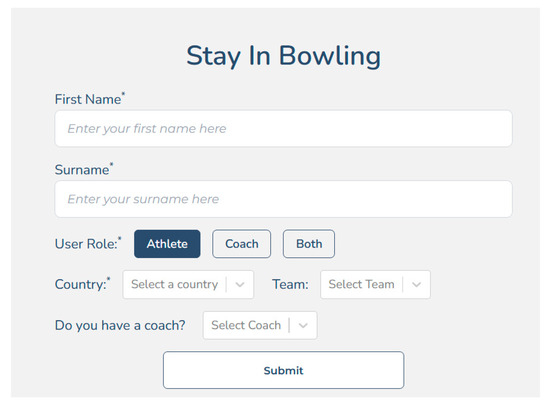
Figure 14.
Web application role selection. The user selects if he/she is athlete, coach or both.
The Node.js server retrieves the data sent from the aforementioned mobile application and stores them in the MySQL database. When users access the dashboard, the frontend application sends API requests to the backend to retrieve the required feedback. The frontend application visualizes the data using charts and graphs, providing athletes’ metrics corresponding to the number of steps, time duration and step direction per attempt during a time period. The athlete role has access only to his/her metrics (Figure 15, Figure 16 and Figure 17). However, the coach role has access to all his/her athletes. The athlete/coach role has access to his/her metrics as athlete and to his/her athletes as coach. For a coach, there is a filter with the selection of coach (himself/herself only), team and country where he/she is coaching (Figure 18 and Figure 19). There is also the administrator role, not visible to the users, where all selections are open.

Figure 15.
Web application Table or Graph selection.

Figure 16.
Web application Table selection.
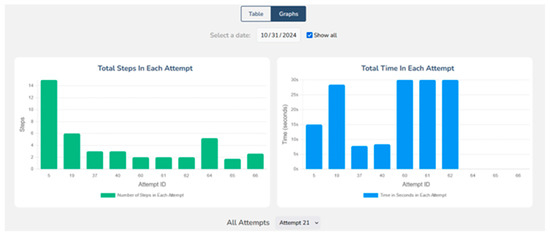
Figure 17.
Web application Graph selection.

Figure 18.
Web application Filter selection for coaches.
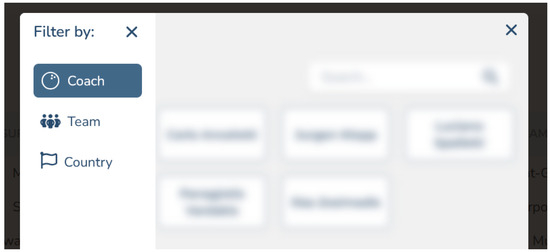
Figure 19.
Web application filters.
5. Material and Method
5.1. Material
During all evaluation activities, every participant was measured by the proposed IoT toolbox to obtain information regarding the athlete’s footwork.
5.2. Participants
In order to explore the evaluation of the proposed step tracking system with regard to the “USE” questionnaire [18], 27 participants took part in an assessment activity. The participants comprised 19 males and 8 females. Considering their age, they were separated into age intervals (Table 1). Furthermore, there were 3 elite athletes, 2 coaches and 22 novice bowlers. Before this experiment, all participants signed a consent form.

Table 1.
Participant age intervals.
5.3. Instruments
The instruments used to answer our research evaluation are presented in the paragraphs below.
USE Questionnaire
Athletes and coaches were asked to complete an online questionnaire after an evaluation activity where they practiced their bowling approaches under the proposed system support. The questionnaire was Lund’s “USE” questionnaire, which is designed to effectively measure the most important aspects of a product’s usability. It consists of 30 questions grouped into four dimensions: (a) Usefulness, (b) Ease of use, (c) Ease of Learning and (d) Satisfaction. According to the author of the questionnaire, the initial 30 questions can be restricted to 17, taking into account only items loaded strongly on the four aforementioned factors. The question type is a 7-point Likert rating scale, with the following anchors: 1 strongly disagree, 2 disagree, 3 slightly disagree, 4 neutral, 5 slightly agree, 6 agree and 7 strongly agree [18].
5.4. Procedure
This evaluation activity followed a procedure consisting of two stages:
- In the first stage, athletes were trained under the support of the proposed step tracking system. Thus, the athlete stepped on the bowling lane until the ball throw, and his/her coach watched the detected metrics on the screen of the mobile application. At the end of every approach, the athlete and the coach reconsidered the athlete’s footwork, utilizing the mobile application and the dashboard to try and figure out possible improvements.
- In the second stage, after the end of training, athletes and their coaches were navigated through a link to an online copy of the “USE” questionnaire to answer it.
5.5. Data Analysis
The data collected from respondents were analyzed in order to examine the achievement of every research goal. Statistical analysis was performed utilizing the SPSS 21 statistical package (IBM, Armonk, NY, USA).
Before any statistical procedure, a reliability test was applied for each one of the four dimensions of the “USE” questionnaire determined by the Cronbach alpha measure. The Usefulness dimension resulted in 0.97; Ease of Use resulted in 0.95; Ease of Learning resulted in 0.93; and Satisfaction resulted in 0.97. Thus, each dimension had an internal consistency (Cronbach’s alpha) higher than 0.70. According to Nunnally [19], alphas above 0.70 are acceptable.
In order to explore the research goals concerning the usability of the proposed solution, the system was evaluated by grouping the athletes’ and coaches’ answers for each factor of the USE questionnaire separately i.e., the usefulness, the ease of use, the ease of learning and the satisfaction. The result comprised four averages derived from athletes’ and coaches’ responses to each separate question. [20].
We then carried out descriptive statistics for each individual dimension of the “USE” questionnaire.
6. Evaluation Results and Discussion
6.1. Evaluation Results
In this section, we examine the participants’ (25 athletes and 2 coaches) perceived usefulness, ease of use, ease of learning and satisfaction.
The mean value (M) for the “Usefulness” dimension is 5.08, with standard deviation (SD) = 0.24. The mean value for the “Ease of Use” dimension M is 5.21, with SD = 0.17. Moreover, for the “Ease of Learning” dimension, the mean value M is 5.36, with SD = 0.18. Finally, for the “Satisfaction” factor, the mean value M is 5.17, with SD = 0.07 (Table 2).

Table 2.
USE questionnaire evaluation for each dimension.
In Table 3, there are analytical results of the affirmative responses for the “Usefulness” dimension.

Table 3.
Affirmative percentages for “Usefulness”.
In Table 4, there are analytical results of the affirmative responses for the “Ease of Use” dimension.

Table 4.
Affirmative percentages for “Ease of Use”.
In Table 5, there are analytical results of the affirmative responses for the “Ease of Learning” dimension.

Table 5.
Affirmative percentages for “Ease of Learning”.
In Table 6, there are analytical results of the affirmative responses for the “Satisfaction” dimension.

Table 6.
Affirmative percentages for “Satisfaction”.
6.2. Discussion
The four averages of athletes’ and coaches’ responses grouped for each of the four separate dimensions of the “USE” questionnaire (Table 2) showed that their opinion was fairly positive, since the average values were higher than 3.5 (7/2).
Thus, considering the first research question (Q1: Usefulness, Mean = 5.08), athletes and coaches estimated that the proposed system is a useful support for training activities.
Furthermore, considering the second research question (Q2: Ease of Use, Mean = 5.21), athletes and coaches did not encounter any major difficulties in applying the proposed system in their training.
In addition, considering the third research question (Q3: Ease of Learning, Mean = 5.36), athletes and coaches did not encounter significant difficulties in comprehending the feedback provided by the step tracking system.
Moreover, considering the fourth research question (Q4: Satisfaction, Mean = 5.17), athletes and coaches enjoyed the experience of training with the proposed system.
The aforementioned results are in line with the research stating that athletes who perform sports supported by computerized and electronic platforms experience transformative, immersive and engaging advancements [21]. Furthermore, interactive and technologically supported methods of training add more enjoyment and are considered more attractive compared to conventional ones [22,23]. It is commonly accepted that user acceptance is a critical factor that determines the use of a product. In addition, negative perceptions of a product usually result in limited use of it.
Furthermore, analytically, the affirmative percentages for every question in every dimension are all above the average of 50%. In fact, except for three (3) percentages (the fourth for “Usefulness”, the last for “Ease of Use” and the first for “Ease of Learning”), the rest are significantly greater than 50%.
Thus, the positive results of the statistical analysis of the “USE” questionnaire are quite encouraging, showing the potential of the proposed step tracking system to be quite a useful and supportive bowling training equipment.
The proposed system is providing real-time feedback detecting technical details in footwork that are not easily perceived by the naked eye. The results showed that the elite and novice athletes as well as the coaches participated in the evaluation activity, appreciated the usefulness of this feedback as a valuable instructional or self-regulation support aiming to performance improvement.
Besides, the aforementioned quantitative assessment, the two coaches participated in the evaluation activity, expressed their views about the proposed system in an informal discussion. They highlighted the remarkable support provided by the proposed system mainly for novice bowlers’ training. They called the proposed system a “smart coach assistant”, which is very comfortable since there is no physical contact with the sensors of the IoT toolbox.
7. Limitations
The present study has certain limitations that should be taken into consideration when interpreting the findings. The sample in the presented study is relatively small; this means that more experiments should be conducted. However, it is unfortunately very difficult to prepare a study with a larger group of bowling athletes or coaches, since bowling is not a very popular sport. In fact, most people consider bowling to be more of an entertainment activity than a sport.
Although additional research is needed to further validate and refine the proposed system, the results of our study, in conjunction with the size of the sample used and the breadth of the variables examined, show that this system, apart from being cost-effective, is also a useful training equipment.
Moreover, in cases of running very quickly (sprint), the sensors used were not always estimating the number of steps accurately. There were some cases where the estimated number of steps by the system was less (usually one less) than the actual steps. In the specific case, these sensors are utilized, this is not a problem, since in bowling the athletes are not running too fast.
However, in cases of other sports like long jump, high jump or triple jump where footwork is faster and is applied in a restricted area so that it can be detected, the proposed system could be applied utilizing more accurate ultrasonic sensors.
8. Conclusions and Future Steps
This research focused on four research goals concerning the utilization of the proposed IoT toolbox as training equipment and its corresponding mobile application and dashboard:
- Athletes’ and coaches’ perceived usefulness (Q1),
- Athletes’ and coaches’ perceived ease of use (Q2),
- Athletes’ and coaches’ perceived ease of learning (Q3),
- Athletes’ and coaches’ satisfaction with the training experience supported by the proposed system (Q4).
The evaluation results showed that most users were quite satisfied with the usefulness, ease of use and ease of learning of the proposed training system. In addition, there was a large number of athletes who experienced positively the interactive training utilizing the proposed step tracking system. Therefore, we could summarize that athletes’ and coaches’ perceived attitude toward utilizing the presented system was quite satisfactory.
Furthermore, since most participants in the evaluation activity were novice bowlers, the evaluation results are quite encouraging, considering the potential of the proposed system as a valuable support for novice bowlers.
Future research should extend to larger samples, mainly of novice bowlers who are in the development stages of their training. In addition, we intend to extend the training period for utilizing the proposed system to get more results about the athletes’ evolution in footwork technique and performance.
Moreover, in future steps, we could combine stepping patterns with increased performance according to athletes’ features (i.e., right or left footed) utilizing machine learning techniques to provide adaptable training instructions.
Author Contributions
Conceptualization, H.A. and T.T.; methodology, H.A., L.K. and T.T.; software, H.A., L.K. and D.Z.; validation, H.A. and T.T.; formal analysis, H.A.; investigation, H.A.; resources, H.A.; data curation, H.A.; writing—original draft preparation, H.A.; writing—review and editing, L.K., D.Z., I.S. and T.T.; visualization, H.A., L.K. and T.T.; supervision, I.S. and T.T.; project administration, L.K. and T.T. All authors have read and agreed to the published version of the manuscript.
Funding
This research was funded by Europe (ERASMUS+), grant number 101090420.
Institutional Review Board Statement
All subjects gave their informed consent for inclusion before they participated in the study. The study was conducted according to the guidelines of the Declaration of Helsinki and approved by the Institutional Review Board (or Ethics Committee) of Institutional Ethics Committee of Aristotle University of Thessaloniki (Approval Code: 96207/2024; Approval Date: 23 April 2024).
Informed Consent Statement
Informed consent was obtained from all subjects involved in the study. Written informed consent was obtained from subjects to publish this paper.
Data Availability Statement
Data are being prepared for publication. The data presented in this study are available upon request from the corresponding author.
Acknowledgments
The authors of this research would like to thank the STAYinBowling Erasmus+ Sport (project team, who generously shared their time, experience and materials for the purposes of this paper.
Conflicts of Interest
The authors declare no conflicts of interest.
References
- Cohen, H. IoT Applications in Sports. 2019. Available online: https://www.iotforall.com/iot-applications-sports (accessed on 10 August 2024).
- Donelly, C. Why Do People Lawn Bowl and Why Do They Stop? Available online: https://biasedbowls.ca/2021/02/19/why-do-people-lawn-bowl-and-why-do-they-stop/ (accessed on 5 July 2023).
- McNitt-Gray, J.L.; Sand, K.; Ramos, C.; Peterson, T.; Held, L.; Brown, K. Using technology and engineering to facilitate skill acquisition and improvements in performance. Proc. Inst. Mech. Eng. Part P J. Sports Eng. Technol. 2015, 229, 103–115. [Google Scholar] [CrossRef]
- Bellimg, P.K.; Ward, P. Time to start training: A review of cognitive research in sport and bridging the gap from academia to the field. In Proceedings of the 6th International Conference on Applied Human Factors and Ergonomics and the Affiliated Conferences, AHFE, Las Vegas, NV, USA, 26–30 July 2015. [Google Scholar]
- The Evolution of Bowling Technology: From Pins to Smart Bowling Balls. Available online: https://richmond40bowl.com/the-evolution-of-bowling-technology-from-pins-to-smart-bowling-balls/ (accessed on 5 September 2024).
- Unlocking the Potential of AI CORE in Bowling. Available online: https://www.stormbowling.com/optimize-bowling-scores-ai-core (accessed on 7 September 2024).
- Hon, T.M.; Senanayake, S.A.; Flyger, N. Biomechanical analysis of 10-pin bowling using wireless inertial sensor. In Proceedings of the IEEE/ASME International Conference on Advanced Intelligent Mechatronics, Singapore, 14–17 July 2009; pp. 1130–1135. [Google Scholar] [CrossRef]
- Razman, R. Critical Parameters of the Delivery in Ten Pin Bowling. Ph.D. Thesis, 2013. [Google Scholar]
- Razman, R.; Abas WA, B.W.; Othman, N. A Front foot slide variability and its relation to tenpin bowling performance. In Proceedings of the 28 International Conference on Biomechanics in Sports, Marquette, MI, USA, 19–23 July 2010. [Google Scholar]
- Chu, D.P.; Zhang, B.; Mau, K. Tenpin Bowling Technique on Elite Players. In Proceedings of the 20th International Symposium on Biomechanics in Sports, Canoas, Brazil, 21–25 July 2002; Available online: https://www.semanticscholar.org/paper/TENPIN-BOWLING-TECHNIQUE-ON-ELITE-PLAYERS-Chu-Zhang/09430aa65eebae288363166dde712ede9db0576c (accessed on 10 November 2024).
- BowlingBall. Available online: https://www.bowlingball.com/BowlVersity/bowling-accuracy-is-in-the-feet (accessed on 20 March 2023).
- Bowling Tips: Increase Bowling Accuracy with Footwork Synchronization. Available online: https://www.happybowlers.com/bowling-tips-increase-bowling-accuracy-with-footwork-synchronization/ (accessed on 10 July 2024).
- Wei, Y. Applications of Ultrasonic Sensors: A Review. Appl. Comput. Eng. 2024, 99, 144–148. Available online: https://www.researchgate.net/publication/386118233_Applications_of_Ultrasonic_Sensors_A_Review (accessed on 1 November 2024). [CrossRef]
- Ureña, J.; Mazo, M.; García, J.J.; Hernández, Á.; Bueno, E. Classification of reflectors with an ultrasonic sensor for mobile robot applications. Robot. Auton. Syst. 1999, 29, 269–279. [Google Scholar] [CrossRef]
- A Detailed Guide to Ultrasonic Sensors. Available online: https://evelta.com/blog/a-detailed-guide-to-ultrasonic-sensors/ (accessed on 20 November 2023).
- URM37 V3.2 ULTRASONIC SENSOR, Description. Available online: https://www.botnroll.com/en/ultrasonic/473-urm37-v32-ultrasonic-sensor.html (accessed on 15 February 2024).
- Detecting Movement Direction with Two Ultrasonic Distance Sensors. Available online: https://www.sensingthecity.com/detecting-movement-direction-with-two-ultrasonic-distance-sensors/ (accessed on 10 December 2023).
- Lund, A.M. Measuring Usability with the USE Questionnaire. Usability Interface 2001, 8, 3–6. [Google Scholar]
- Nunnally, J.C. Psychometric Theory, 2nd ed.; McGraw-Hill: New York, NY, USA, 1978. [Google Scholar]
- Boone, H.N.; Boone, D.A. Analyzing Likert Data. J. Ext. 2012, 50, 48. [Google Scholar] [CrossRef]
- Elvitigala, S.; Karahanoğlu, A.; Matviienko, A.; Vidal, T.L.; Postma, D.; Jones, M.; Montoya, M.; Harrison, D.; Elbæk, L.; Daiber, F.; et al. Grand Challenges in SportsHCI. In Proceedings of the 2024 CHI Conference on Human Factors in Computing Systems (CHI ’24), Honolulu, HI, USA, 11–16 May 2024. [Google Scholar] [CrossRef]
- Sheehan, D.; Katz, L. Using Interactive Fitness and Exergames to Develop Physical Literacy. Phys. Health Educ. J. 2010, 76, 12–19. [Google Scholar]
- Maillot, P.; Perrot, A.; Hartley, A. Effects of interactive physical-activity video-game training on physical and cognitive function in older adults. Psychol. Aging 2012, 27, 589–600. [Google Scholar] [CrossRef] [PubMed]
Disclaimer/Publisher’s Note: The statements, opinions and data contained in all publications are solely those of the individual author(s) and contributor(s) and not of MDPI and/or the editor(s). MDPI and/or the editor(s) disclaim responsibility for any injury to people or property resulting from any ideas, methods, instructions or products referred to in the content. |
© 2025 by the authors. Licensee MDPI, Basel, Switzerland. This article is an open access article distributed under the terms and conditions of the Creative Commons Attribution (CC BY) license (https://creativecommons.org/licenses/by/4.0/).